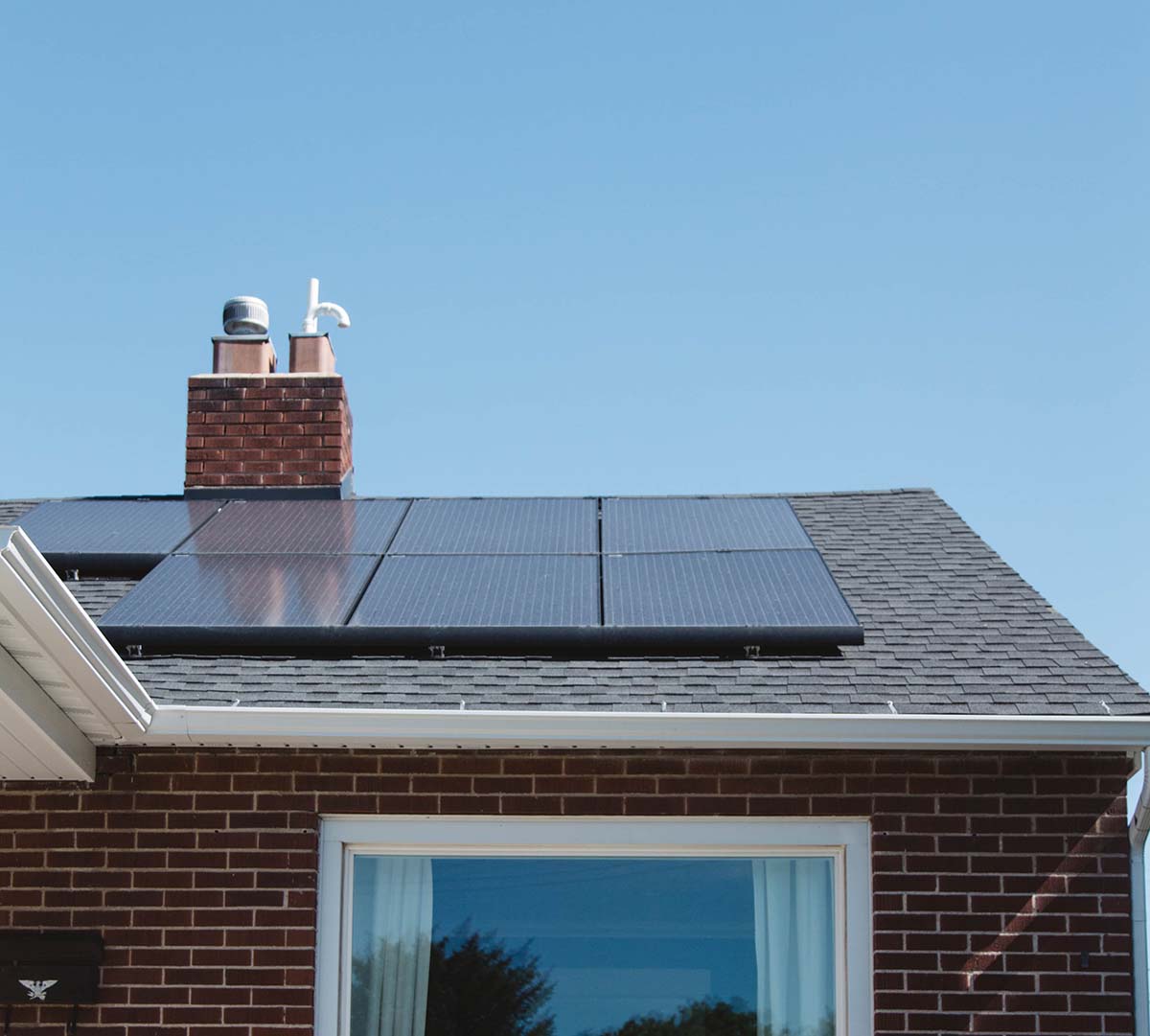Heat in Buildings
NESCAN Hub
#Buildings & Energy
Publish Date: March 2024
Last Updated: March 2024
About one-third of global energy is consumed in buildings. In community, public and commercial buildings as well as our homes.
We depend on energy in so many ways: space heating, water heating, cooling, ventilating, lighting, cooking, refrigerating, operating and charging devices.

Warm homes and affordable heating
For the average Scottish household, heating accounts for more carbon dioxide emissions than any other aspect of our lives. Much of Scotland's housing is of older standards, lacking the quality of the homes of many of our European neighbours. Many of our homes are damp, draughty and have poor air quality that leads to health problems. If we improve the energy efficiency of our homes we will create green jobs, reduce fuel bills, reduce fuel poverty, tackle health inequalities and improve outcomes for our children and young people.
The climate emergency could be an opportunity to help address outcome inequalities caused by bad housing at the same time as reducing emissions and our reliance on oil and gas. This is one aspect of climate justice, whereby the people who are most vulnerable or at risk from climate change should not be expected to bear an unfair share of the costs and will in fact benefit from the measures necessary to reduce energy usage.
How can we reduce both our energy consumption and our reliance on oil & gas?
- by improving the energy efficiency of our homes.
- by installing renewable heating and energy technology.
Retrofitting
Retrofitting is the process of bringing existing buildings up to a high standard of energy efficiency. A retrofit plan provides a step-by-step guide to retrofitting the building in stages, as and when the opportunity and finance allow. It is claimed that using the highest energy efficiency retrofit, fuel bills can be reduced by 80%.
PAS 2035 is the new British standard for creating energy efficient homes. These standards aim to ensure that retrofit projects deliver their intended outcomes for the right cost.
A qualified retrofit coordinator can help you navigate the whole process by acting as Project Manager. The role of the Retrofit Coordinator was established by PAS2035. They are responsible for ensuring compliance with procurement, specification, and delivery of domestic retrofit projects.
The fabric-first concept is based on improving the energy efficiency of the building before introducing a new renewable heating system. Otherwise, the uninsulated building would require a much higher capacity and expensive heating system.
Street-by-street retrofit would be ideal, as homeowners would benefit from economies of scale, but challenging to organise.
What are the main challenges?
- Lack of information about the benefits and options.
- Cost – although some grants may be available.
- Disruption – occupants may have to move out while the work is done.
- Lack of skilled, trusted, qualified trades, especially in the North East.
- Previous bad experiences with badly installed insulation.
- Coordination of mixed tenure types including absentee landlords.
Information and awareness
You can help to spread the word about the benefits of increasing energy efficiency around your community and encourage others to insulate, retrofit and reduce their energy use. Groups in some communities in the North East, like Daviot, Banchory, Kemnay and Udny, are already doing this.
NESCAN members, Udny Climate Action and Zero Carbon Daviot, have created an information leaflet to publicise and explain the retrofit process to their communities. Our Future Homes – A Guide to Retrofit and Heat Pumps
Some of our members have come together to form NESFIT, a community-led retrofit cooperative set up to help householders navigate the complex journey of reducing carbon emissions and achieve warmer, healthier, emissions-free homes.
Greener Kemnay successfully bid for funding for purchase several items of equipment that can be used for survey work to identify cold spots, and draughts so that a proper plan for insulation improvements can be created. They are working with NESFIT to recruit volunteers and potential retrofit assessors who can be trained to use the equipment.
Community Buildings
Rural adaptation and resilience plans depend upon community buildings in times of winter storms and power outages. At other times they may offer facilities for warm spaces, online access, meals, pantries, surplus food distribution, meetings, clubs, councillor surgeries, dancing classes and exercise sessions - these are just some of the services and activities that rely on community buildings.
Many of these buildings are run by groups of volunteers from their local area, often for a peppercorn rent or through an asset transfer process. The buildings are often old, with cold and drafty rooms. Improving the energy efficiency of these buildings can transform the wellbeing of the community and reduce the costs of providing services. Starting by creating warm and cost-efficient community centres will also serve as an exemplar for the community of the benefits of retrofit for their homes.
Like many community groups and organisations, you may have your own buildings, so you can lead by example and retrofit these to the highest standards. The most recent standards that any retrofit should be working to are the PAS2030 and PAS2035 Standards.
Funding retrofit for community buildings
Let's do Net Zero Community Buildings The Community Buildings Fund helps community organisations reduce their building energy costs and greenhouse gas emissions by installing renewable technologies such as heat pumps, batteries, and solar photovoltaic (PV) panels, along with energy efficiency measures. Grants of up to 80% of eligible costs up to a maximum of £80,000 are available until 31 March 2025. Funding is subject to availability and subject to the applicant’s ability to complete the project and claim all funds by 31 March 2025.
Local Energy Scotland manage CARES - the Scottish Government’s Community and Renewable Energy Scheme. CARES supports communities across Scotland to engage with, participate in and benefit from the energy transition to net zero emissions.
CARES can provide a package of support for a wide range of projects including installing renewable technologies in community buildings, community benefits and shared ownership.
Business Energy Scotland offer free Energy Efficiency Assessment Reports and funding may be available through Business Energy Scotland’s cashback scheme
Foundation Scotland manage a number of funds including the Vattenfall Unlock Our Future Fund.
Funding a retrofit for your home
Home Energy Scotland provides free, impartial advice for homeowners on energy saving, keeping warm at home and renewable energy.
HES provides interest free loans and cashback for energy saving measures such as loft, wall and floor insulation and double glazing as well as for heat pumps. However funding schemes change, as do building standards.
The Energy Savings Trust have their own free Funding Finder to help householders search for government grants, discounts and funding streams that may apply in their area.
Warmer Homes Scotland may provide full cost grants plus loans for a range of measures for carers, people with disabilities and older owner occupiers or tenants who meet certain criteria.
Loans and cashback for energy efficiency initiatives and low carbon heating systems may be available from Zero Waste Scotland.
Funding may be available from utility companies or through the Energy Company Obligation Scheme. You can get more information about this scheme from ofgem and HES can advise.
A few financial institutions support retrofitting, such as the Ecology Building Society.
Sustainable Renovation Guides:
The Energy Savings Trust guide on how to insulate your home and stay warm this winter provides information about how much heat is lost through uninsulated walls and roofs, and an idea of the costs involved.
LETI’s Climate Emergency Retrofit Guide shows how we can retrofit our homes to make them fit for the future and support the UK’s Net Zero targets.
The Sustainable Renovation Guide from The Pebble Trust describes ten ways in which those involved in the retrofit and renovation of Scotland’s homes can improve upon current practice, achieving better energy performance as well as gaining wider sustainability benefits.
The Trustmark Guide on Retrofit from the only Government Endorsed Quality Scheme for work carried out in or around your home
Website to find our locally written booklet on retrofit and heat pumps.
If you’d like to find out more about existing projects that are being delivered by community groups in the North East, you can explore the websites of some NESCAN Member organisations with a focus on Buildings and Energy:
